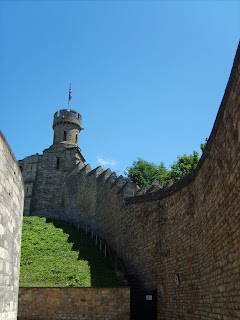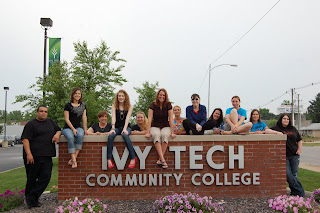




Thursday June 17 – Day 6
Sometimes when traveling it is the tiny things that happen that really have an impact on you. For instance, this morning, while riding the coach to Lincoln, I could not help but notice that about twenty minutes into the ride all of the passengers grew exceedingly quiet. While at first I recognized this as sheer exhaustion settling in among the weary travelers, I then realized that it was so much more than that. It was a display of how very comfortable we have all become.
We made our way to Lincoln excited that we had the most beautiful weather thus far on the trip, and were immediately awestruck when we pulled into the square and laid eyes on Lincoln Cathedral, which towers into the skyline with a demanding presence. Finding ourselves with a little time to spare before our tour was set to start, we took the opportunity to wander the streets of the quaint town and relished in the peaceful atmosphere. While most of us stayed within the area of the main square, a few adventurous students decided to head down the road a small way, and, on their way back, discovered one of Lincoln’s less notorious features, a large hill that sits at about a forty-five degree incline.
We started our day with a tour of Lincoln Castle, an imposing structure that displays the Norman Motte-and Bailey style of architecture. The castle was originally built by William the Conqueror to be used as a military fortress. One of the reasons that he chose the location was because it afforded a view that spanned twenty-five miles giving him approximately a two day advantage over any opposition that may try to attack. The castle was originally constructed with wood from Sherwood Forest, but was redone in stone by 1115.
The grounds of the Lincoln Castle also contains an old jailhouse, a courthouse that is still currently active, and an exhibit that proudly displays one of only four remaining original copies of the Magna Carta, and a copy of the Charter of the Forest, a 1217 re-issue of the Magna Carta. After touring all of these sites we sat in the castle yard to have our lunch, soak up some good weather, and prepare for our next tour.
We then made our way to Lincoln Cathedral, which is only two years older than the castle itself, and found ourselves once again stunned by the beauty within its walls. While there are simply too many details about the Cathedral to go into them in any great detail, I will share some of the more interesting tidbits our guide shared with us. If a visitor is lucky enough to get a view from the top they will notice that the structure is actually shaped like a cross. I was also quite interested to hear that the Cathedral contains an organ that, in 1869, became one of the first to be converted to electric and the second story of the Cathedral is filled with the organ pipes that are over three thousand in number. Lastly, being a huge fan of Dan Brown I was very excited to hear that Lincoln Cathedral was used to portray West Minster Abbey in the popular film Da Vinci Code.
There is no way to adequately describe the effect these locations have had on all of our senses. This trip is truly the opportunity of a lifetime, and, while it is difficult, I could not be happier to be sitting on this side of the computer as the one attempting to express the beauty and wonder that we have seen along the way.
Molly Hodgen
































